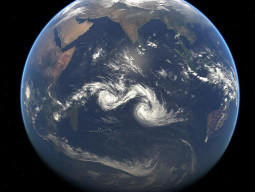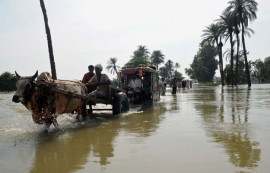
It was recently reported in The Express Tribune that some serious issues were presented before the Senate of Pakistan on sea intrusions in Karachi and Thatta by the National Institute of Oceanography and the Sindh Revenue Board. The core issues that could be major causes of future sea intrusion, however, remained unexplored in the proceedings. Nowadays, terms like ‘climate change’ and ‘sea intrusion’ are in vogue but the roots of these phenomena are barely discussed. Their roots lie in deforestation. In Sindh, at one point in time, there were 2.1 million acres of riverine forests. Today, one can clearly see that 99 per cent of forest area has been razed for agriculture.
In the Sindh Water Sector Improvement Project, it was proposed that one of the possible remedies for deforestation was to use drainage water in a conjunctive or cyclic way with available sweet water for reforestation. International consultants for this study estimated this to be a financially viable solution to the problem of deforestation. The drainage water in the Left Bank Outfall Drains (LBOD) and the Kotri Surface Drains of the Indus basically consist of excess water drained by farmers, which is re-useable. During field visits to the LBOD and the Kotri Surface Drains, one could easily taste the fresh water in these drains passing through barren lands. However, this water is now contaminated with hazardous effluent from sugar mills adversely impacting the livlihoods of fishermen.
Another problem is that of breaches in dykes created at the behest of influential people during floods. After the 2010 floods, the Supreme Court’s Flood Commission noted that the breach in the Tori dyke occurred due to obstructions in waterways. The GIS images show that the river waterway near Ghotki was encroached. The width of the waterway was originally almost 20 kilometres but to protect illegal encroachments in the river bed, new bunds were constructed and the waterway is now just 9.78 kilometres wide. The narrowing of waterways can have numerous adverse impacts but those are being ignored. The National Highway Authority is also contributing to the problem by building bridges that have short waterway spans. In a recent study on the Guddu Barrage Rehabilitation Project by a group of international consultants, it emerged that the river bed between the Guddu and Sukkur barrages is rising at the rate of one foot every 10 years. At this rate, we must brace ourselves to seeing our rivers flowing over barrages.
Our environmentalists should evaluate the impact of fertilisers and pesticides that are applied to crops. We need to understand the effects of excess nitrogen and pesticides in agriculture drainage water. In developed countries, people often avoid the direct use of river water and its fish products as these contain high nitrogen content, which is hazardous to health. Also, our experts and research institutes are continuously ignoring the ground water morphology of river basins. We should also take notice of the decrease in flood waters reaching the boundaries of Sindh. Almost 0.8 million cusecs passed from Jhang during the 2014 floods in Punjab, but this was reduced to 0.35 million cusecs at Guddu.
With all the challenges that we face, what is lamentable is that we don’t have the aptitude to evaluate our technical problems on the basis of available data and research reports to find good solutions.
Published in The Express Tribune, March 12th, 2015.
Like Opinion & Editorial on Facebook, follow @ETOpEd on Twitter to receive all updates on all our daily pieces.































































COMMENTS (1)
Comments are moderated and generally will be posted if they are on-topic and not abusive.
For more information, please see our Comments FAQ